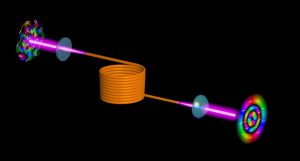
In the demonstration, by the US University of Rochester, the fibre was constantly measured by a probe beam passing down the fibre in the opposite direction to the would-be data-carrying beam.
At the data sending end, the probe beam was measured, then the transmit wave-front was digitally pre-shaped using a spatial light modulator to be the phase conjugate of the probe beam.
“When an optical beam with perfect wave-fronts passes through the multimode fibre, it comes out badly distorted,” said Professor Robert Boyd. “If we use a mirror to send the wave-front back, it will become even more distorted. But if we instead reflect it off a mirror, and also flip the wave-front from front to back, the distortion becomes undone as the waves go back through that distorting medium. In particular, we need perform this procedure for both polarisations simultaneously when the distorting medium is a long multi-mode fibre.”
Holography was used to measure the spatial and polarisation profile of the post-fibre probe beam, using a polarising beam displacer to coherently separate the horizontally and vertically polarised components. These two beams were then combined with a coherent 45° polarised reference plane wave at a beam-splitter, and the resultant interference pattern is recorded by a camera, according to the Nature Communications paper ‘High-fidelity spatial mode transmission through a 1-km-long multimode fiber via vectorial time reversal‘, which describes the work – and is both clearly written and available in full without payment.
Rochester worked with the University of Ottawa, the University of South Florida and the University of Southern California, Los Angeles.